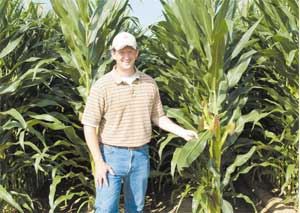|
MSU Researchers Explore Early Corn Planting
MISSISSIPPI STATE, MISS.
As early corn comes to market in July, growers are reminded that timing counts for a lot when it comes to planting corn. That’s why Mississippi State University scientists are researching the effects of planting date, plant population and hybrid selection on field corn yields.
Brien Henry, an associate professor in plant and soil sciences, and his team study the impact of planting higher populations of corn plants earlier in the season. They planted a variety of corn hybrids from March through May at plant populations ranging from 20,000 to 40,000 per acre at Starkville, Brooksville and Verona.

Brien Henry, an associate professor in the Mississippi State University
Department of Plant and Soil Sciences, is visiting a research plot on
June 19, 2014, at the R.R. Foil Plant Science Research Center, commonly
known as North Farm. He is researching the effects of planting date, plant
population and hybrid selection on field corn.
Photo by Mississippi Agricultural and Forestry Experiment Station/David Ammon
“Initial research indicates earlier planting of certain hybrids at certain populations produce higher yields,” Henry said. “Last year, we had a cooler, wetter spring and summer, and the results indicated early planting was better. For every week of delayed planting, we lost 7 bushels of corn per acre. It is important, however, that we continue to repeat these trials at multiple locations over multiple years so we can make an informed recommendation to producers.”
Henry evaluates how different hybrids and plant populations respond to the colder, wetter conditions of early planting. His goals include gathering information about environmental limitations, providing insight on optimal plant populations and exploring whether some hybrid traits allow the crop to overcome the risks and maximize the benefits associated with early planting.
Early planting presents several risks in corn production, including soil compaction, lack of uniformity, stunted stand height and delayed seedling germination, growth and emergence.
Erick Larson, Extension grain crops agronomist and researcher in the Mississippi Agricultural and Forestry Experiment Station, helps growers work through these issues.
“Growers have called this season asking why their corn plants are shorter. Temperatures were exceptionally cold in March and April and didn’t stimulate the same growth that we would see if the stands had been planted later in the season or during a warmer year,” Larson said. “One thing I recommend to growers is when they do plant early, plant an elevated population. By planting more stalks, you’ll put more leaves in the field to do a better job of intercepting available light.”
Despite these risks, early corn planting has benefits as well. Corn uses a lot of water, specifically during its reproductive stage. Based on traditional planting dates, this stage usually falls in June and July, during the often hot, dry Mississippi summer. Corn planted earlier may enter these critical reproductive growth stages in May and early June, when the state enjoys more rainfall, lower temperatures and less chance of drought, thus increasing crop productivity and yield.
Additionally, Henry said growers who bring their corn to market in July, as opposed to August or September, could potentially earn more per bushel because of the timing of the market.
The Mississippi Corn Promotion Board funds this research through producer check-off dollars. ∆
|
|